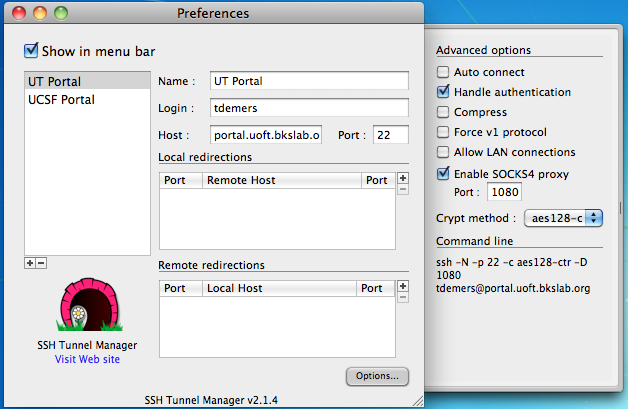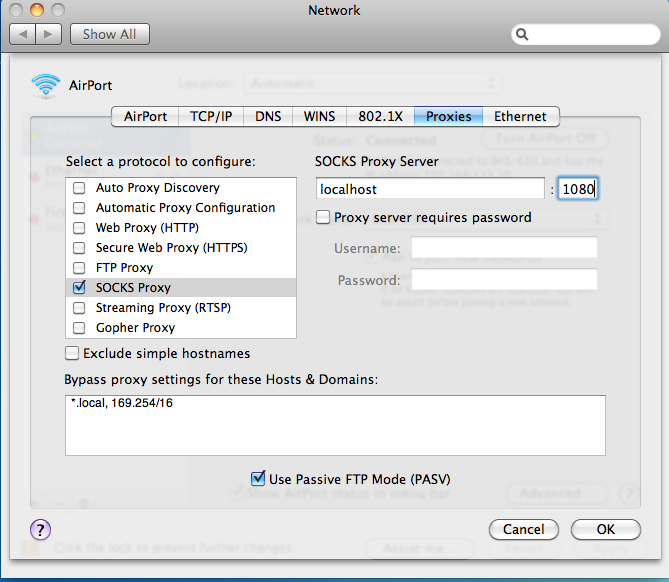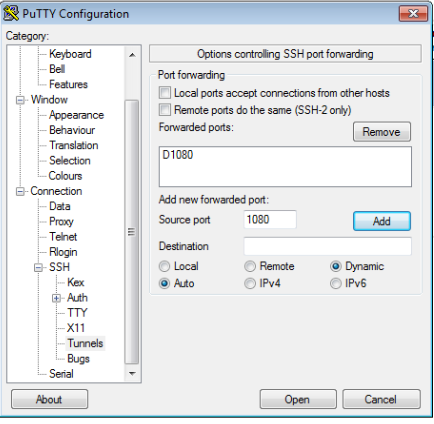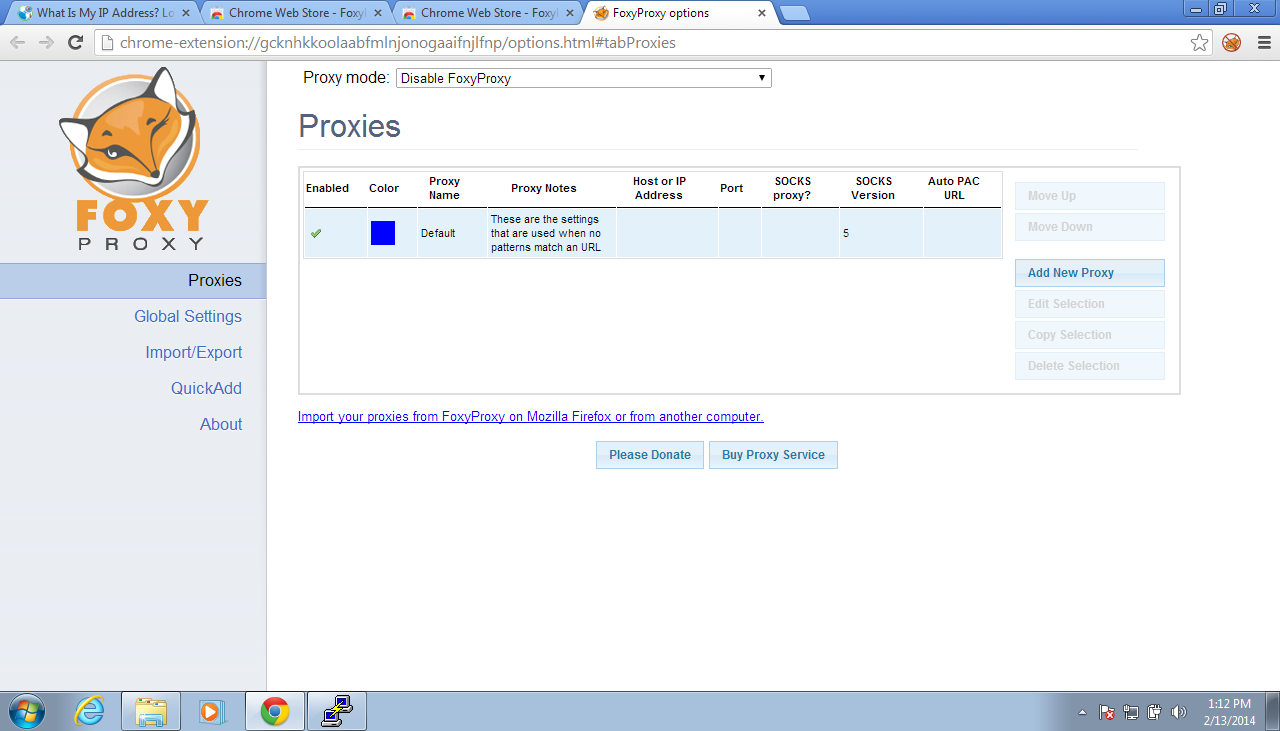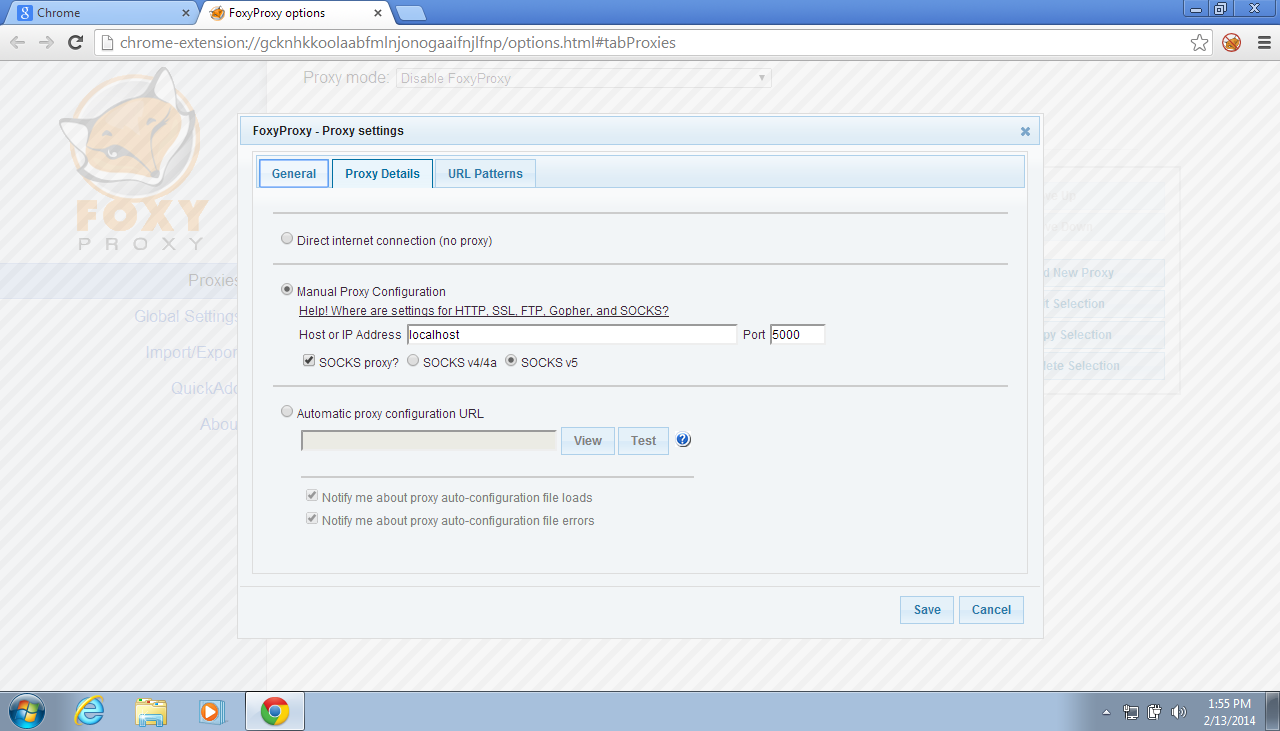How to create a vpn/ssh tunnel: Difference between revisions
No edit summary |
No edit summary |
||
| Line 62: | Line 62: | ||
To test if your tunnel is good, go to: http://whatismyipaddress.com/ | To test if your tunnel is good, go to: http://whatismyipaddress.com/ | ||
This will tell you what ip address you have. If it says | This will tell you what ip address you have. If it says the IP address of the remote host you're connecting to in putty, you are good to go! :) | ||
Your computer will now act as if you were connected to the internet in the lab. | Your computer will now act as if you were connected to the internet in the lab. | ||
| Line 74: | Line 74: | ||
That’s it! | That’s it! | ||
== FOR WINDOWS OS == | |||
Open putty.exe and select the session that you want to use as a ssh tunnel (ie portal.uoft.bkslab.org). | |||
Then click on Connection -> SSH -> tunnels | |||
In Source Port enter 1080 (or any port above 1024). | |||
Then click the Dynamic button and then click Add. | |||
It should look like this: | |||
[[File:proxy1.png]] | |||
Then go back to Session and click Save. | |||
Then download the "standard" version of FoxyProxy here: http://getfoxyproxy.org/downloads.html | |||
Once you’ve downloaded it there should be a little fox picture next to the url bar (upper right hand corner of web browser). Click on that little picture and select Options from the dropdown list. | |||
You should see this: | |||
[[File:foxy1.png]] | |||
Click on Add New Proxy | |||
Then click on the General tab. | |||
Enter a proxy name and then select the Proxy Details tab. | |||
Enter “localhost” in “Host or IP Address” and 1080 for “Port” (or whatever port number you entered in putty). | |||
Click the “SOCKS proxy?” Button and make sure the “SOCKS v5” button is also clicked. | |||
Your screen should look like this: | |||
[[File:foxy2.png]] | |||
Then click Save. | |||
Then click on the fox again on the upper right hand corner and click on “Us proxy whatever_you_named_it Proxy for all URLs” | |||
Then click on putty and open your session. A terminal will pop up and ask for your passphrase. Enter your passphrase (for your ssh key). That’s it! | |||
To test if your tunnel is good, go to: http://whatismyipaddress.com/ | |||
This will tell you what ip address you have. If it says the IP address of the remote host you're connecting to in putty, you are good to go! :) | |||
This session will remain open as long as your ssh putty session is open. | |||
When you are done with your session, exit from the ssh putty session (type exit on the terminal screen). | |||
Then, on your browser, click on the little fox in the upper right hand corner and select “Disable FoxyProxy”. | |||
Revision as of 22:27, 13 February 2014
FOR MAC OS
Go to the app store and search for “ssh tunnel manager”
Download this free app.
Click the “Show in menu bar” button on the upper lefthand corner.
Open it and then click the little ‘+’ sign on the bottom part of the white box.
Enter the following information:
For the Name field, name it whatever you want.
Login: your_user_name
Host: portal.uoft.bkslab.org
Port: ssh_port
Then click on the Options button in the bottom righthand corner.
Make sure “Handle authentication” is checked and check the “Enable SOCKS4 proxy”.
Make sure the port is 1080 (or something above port 1024).
Your screen should look like this:
Then close the SSH Tunnel Manager.
Go to System Preferences -> Network
Click on the connection you are connected to (ie Airport, Ethernet, etc).
Then click on Advanced in the bottom right corner.
Then click on Proxies up in the top right of the box.
Then check SOCKS Proxy
Then under “SOCKS PROXY SERVER” enter localhost and to the right 1080 (or whatever port you decided to use previously).
It should look like this:
Click OK, then apply.
Then go to the ssh Tunnel Manger and click the “play”button on the right hand side:
It should say connected and possibly prompt you for your password (the one associated with your ssh key).
To test if your tunnel is good, go to: http://whatismyipaddress.com/
This will tell you what ip address you have. If it says the IP address of the remote host you're connecting to in putty, you are good to go! :)
Your computer will now act as if you were connected to the internet in the lab.
When you’re done with the vpn session click on the ssh Tunnel Manager and click the “stop” button.
Then go to System Preferences -> Network -> Advanced -> Proxies
and uncheck the SOCKS Proxy, click OK, then apply.
That’s it!
FOR WINDOWS OS
Open putty.exe and select the session that you want to use as a ssh tunnel (ie portal.uoft.bkslab.org).
Then click on Connection -> SSH -> tunnels
In Source Port enter 1080 (or any port above 1024).
Then click the Dynamic button and then click Add.
It should look like this:
Then go back to Session and click Save.
Then download the "standard" version of FoxyProxy here: http://getfoxyproxy.org/downloads.html
Once you’ve downloaded it there should be a little fox picture next to the url bar (upper right hand corner of web browser). Click on that little picture and select Options from the dropdown list.
You should see this:
Click on Add New Proxy
Then click on the General tab.
Enter a proxy name and then select the Proxy Details tab.
Enter “localhost” in “Host or IP Address” and 1080 for “Port” (or whatever port number you entered in putty).
Click the “SOCKS proxy?” Button and make sure the “SOCKS v5” button is also clicked.
Your screen should look like this:
Then click Save.
Then click on the fox again on the upper right hand corner and click on “Us proxy whatever_you_named_it Proxy for all URLs”
Then click on putty and open your session. A terminal will pop up and ask for your passphrase. Enter your passphrase (for your ssh key). That’s it!
To test if your tunnel is good, go to: http://whatismyipaddress.com/
This will tell you what ip address you have. If it says the IP address of the remote host you're connecting to in putty, you are good to go! :)
This session will remain open as long as your ssh putty session is open.
When you are done with your session, exit from the ssh putty session (type exit on the terminal screen).
Then, on your browser, click on the little fox in the upper right hand corner and select “Disable FoxyProxy”.
